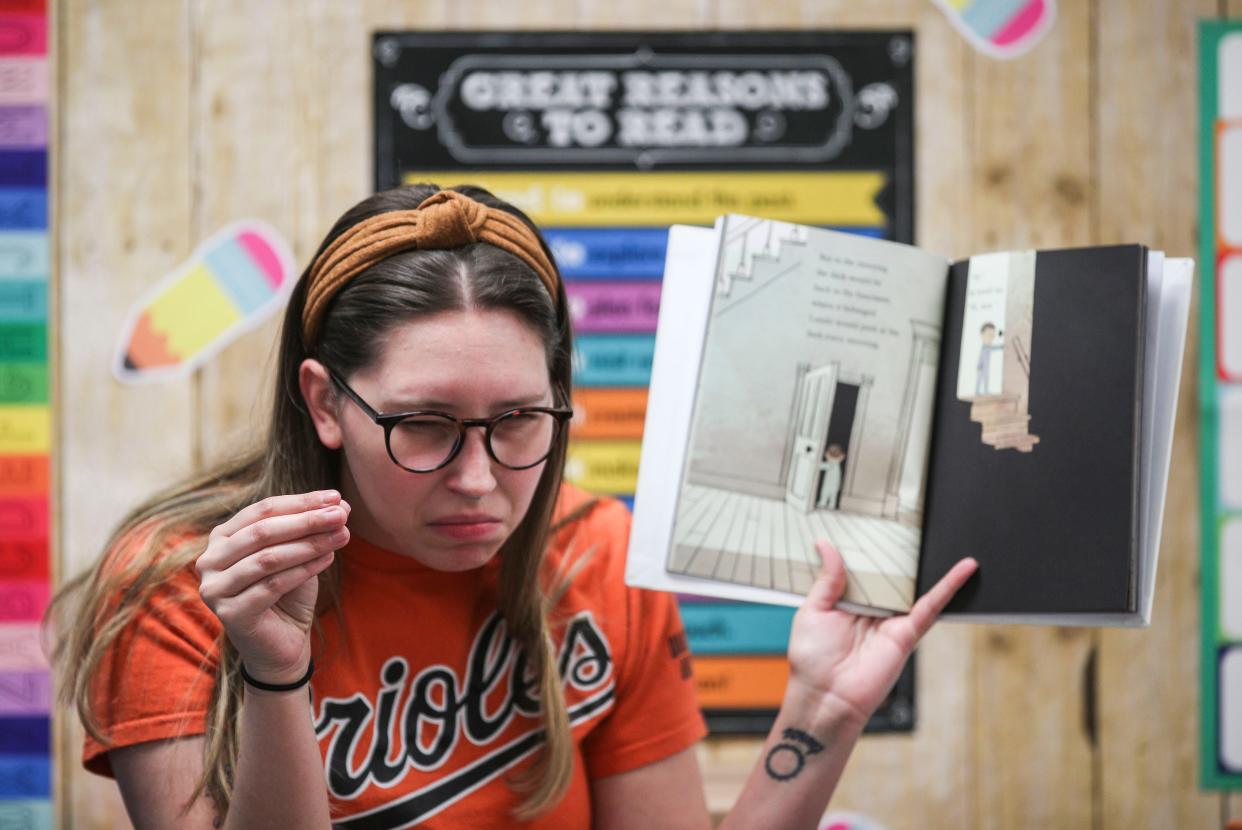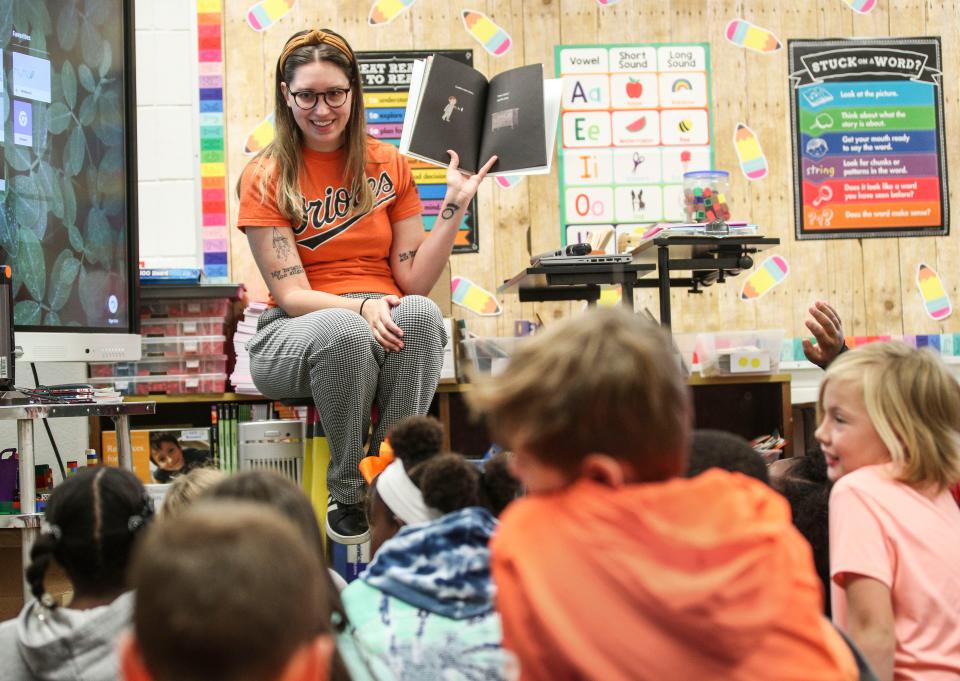Things that go bump in the night: 7 tips to help you write a terrifying, scary story

Folklore, legends and spooky stories have existed as long as the fires they’re often told around.
Musing over ghosts, monsters and the unexplainable is an ancient pastime. You don't have to be Stephen King or Edgar Allan Poe to craft words, characters, and circumstances so frightening that your chest tightens, your spine arches, and every muscle in your body seems to follow along with the tale.
Anyone can tell a spooky story.
With Halloween just around the corner, I sought out some advice on how to add a little extra creepiness to whatever tales you're weaving this October.
Brent Peters, who teaches English II at Fern Creek High School, and Ian Stansel, the director of University of Louisville’s creative writing program, walked me through the mechanics of how to generate ideas, build out scenes and create characters. Samantha Booker, a second-grade teacher at Dunn Elementary, chimed in, too, about how she inspires her very young writers to think creatively and use words that build suspense.
You may likeIt's spooky season! Here are 10+ haunted places to visit within an hour of Louisville
Whether you’re hoping to scare someone for a few minutes or even a few dozen pages, here’s where to get started.
First, start with your own spooky, creepy experiences

Whenever Peters asks a class about whether they've ever experienced anything eerie or spooky, almost every hand in the room goes up.
Even if they haven't met a ghost, most of the time, his students have had at least one mysterious or unexplained thing happen to them. Drawing from your own experience is a really good starting point, he said.
"If I’m telling fiction, I could build it off of that reality," he says. "Or if a ghost story is real to me, then I could just extend it."
More Halloween:BOO! Here are 12+ scary story recommendations for children and adults this Halloween
Read other spooky stories or look at examples of spooky images
Part of what helps writers is reading other writing, Peters says. You don’t necessarily need to read the whole novel, but it can be helpful to pay attention to other spooky works and assess why they make you feel scared or suspenseful.
In the past, he’s given his students a single, scary first line from a story and let them build it out from there. Neil Gaiman’s "Coraline," which begins with “Coraline discovered the door a little while after they moved into the house,” has been a good writing prompt for his students in the past. He just has them rename the main character and start their own story from there.
Using visuals is also a good way to get creativity flowing. In the past, Peters has passed around an eerie photograph and asked students to set the story there. He says it's incredible to watch how each individual student draws from different things in the same photo.
You may like'I can't explain what is going on here.' Inside one of the most haunted spots in Kentucky
Booker took a slightly different, but equally effective approach with her second graders. She encouraged her class to draw a monster first, and then use that to help describe the monster in their story. That helped her new storytellers take something they imagined in their minds and make it more tangible and easier to picture.
Start writing a scary narrative, then break it up
If you're writing a longer story, it's important to have multiple drafts and to try out different ways of building suspense. A lot of authors try to introduce the “scary thing” whether it be a ghost or a monster too early.
"We're really eager to get to that thing because that's what we know we want to write about," Stansel explained. "So, what I would suggest, would be to delay the introduction of that 'scary thing' to build suspense and anticipation of that 'scary thing.'"
If you introduce your showstopper on page 3, then the writer doesn’t have much room to grow on page 10 or 15, Stansel says. The tension has to build throughout the story.
When a writer has all the parts of a story in front of them, Peters encourages his students to shatter the structure and see if they can put it back together in a more interesting or suspenseful way.
You may likeStrange footsteps, unexplained events & a rogue elevator: Are ghosts haunting The Speed?
Beginning a story in middle can actually be really helpful, he says, because it can offer readers a taste of the action to keep them engaged.
"Bending time or manipulating time, or just really thinking about sequencing in ways that were also mysterious," Peters says. "Then the reader kind of has to put together the pieces of the puzzle together."
Create characters the reader cares about
Readers and listeners need to be invested in the story, and one good way to do that is to provide plenty of context about the characters.
Stansel compared it to writing a romance story. In order for the audience to invest in a first kiss, they need to understand what went into building that relationship.
The same theory can be applied to bad or horrific things that happen in spooky stories.
"If you're writing a scary story, and something jumps out and threatens the lives of the characters," he said, "we're going to care about that more if we care about the characters first, and we have to care about the characters first. … Work on the characters and build the characters and try to make them as human as possible."
You may likeSome say 'it's downright haunted.' The spooky tale of this former Kentucky Catholic school
Expand your vocabulary with suspenseful, creepy words
Some words are scarier than others, so Booker began her first scary writing lesson with her students by first reading them "Harry and the Terrible Whatzit" by Dick Gackenback and then asking them to pick out the spooky words in the book. Her class made a list of words that felt creepy and created suspense, and then they used those words to write their own sentence.
Booker taught her students about onomatopoeia, which are words that are vocal imitations of the sounds associated with them. Adding sounds like BOOM, EEK and THUMP help the audience feel like they’re in the room with the character.
Use visual aids to break up the narrative
One way to really engage with the reader — particularly if you’re writing the story instead of speaking it — is to include a found object in the narrative, Peters says.
Adding a letter that’s written in a different font than the text of a story, image, map or a weird signature can help create suspense and make the reader feel like they’re solving the puzzle in the story.
When readers see and find the same things the characters do, it helps them invest in the tale.
You may like'I can't explain what is going on here.' Inside one of the most haunted spots in Kentucky
“It's fun to have to break the text up, so that it's like, ‘oh, wow, now I've got something else to go on,’” Peters said. “I've got more landscape.”
Leave your readers wanting more
One thing to consider when ending your story is that it's OK to leave some things to the imagination.
“Perhaps everything shouldn't be tied up so neatly,” Stansel said.
That doesn’t mean an author should fill a story with random things that are never explained, he said. The narrative has to make sense, but leaving a few mysteries behind can help leave the reader with a sense of uneasiness.
Part of what makes scary stories scary is that the world as we know it is out of balance. It's OK to leave that feeling with the reader even after the story is over.
“If we eat something, and it's good, there's a sort of finish on the tongue,” he said. “We can leave that by keeping a couple of the mysteries open.”
Features columnist Maggie Menderski writes about what makes Louisville, Southern Indiana and Kentucky unique, wonderful, and occasionally, a little weird. If you've got something in your family, your town or even your closet that fits that description — she wants to hear from you. Say hello at mmenderski@courier-journal.com or 502-582-4053.
This article originally appeared on Louisville Courier Journal: Here are 7 tips to help you write a terrifying, scary story

